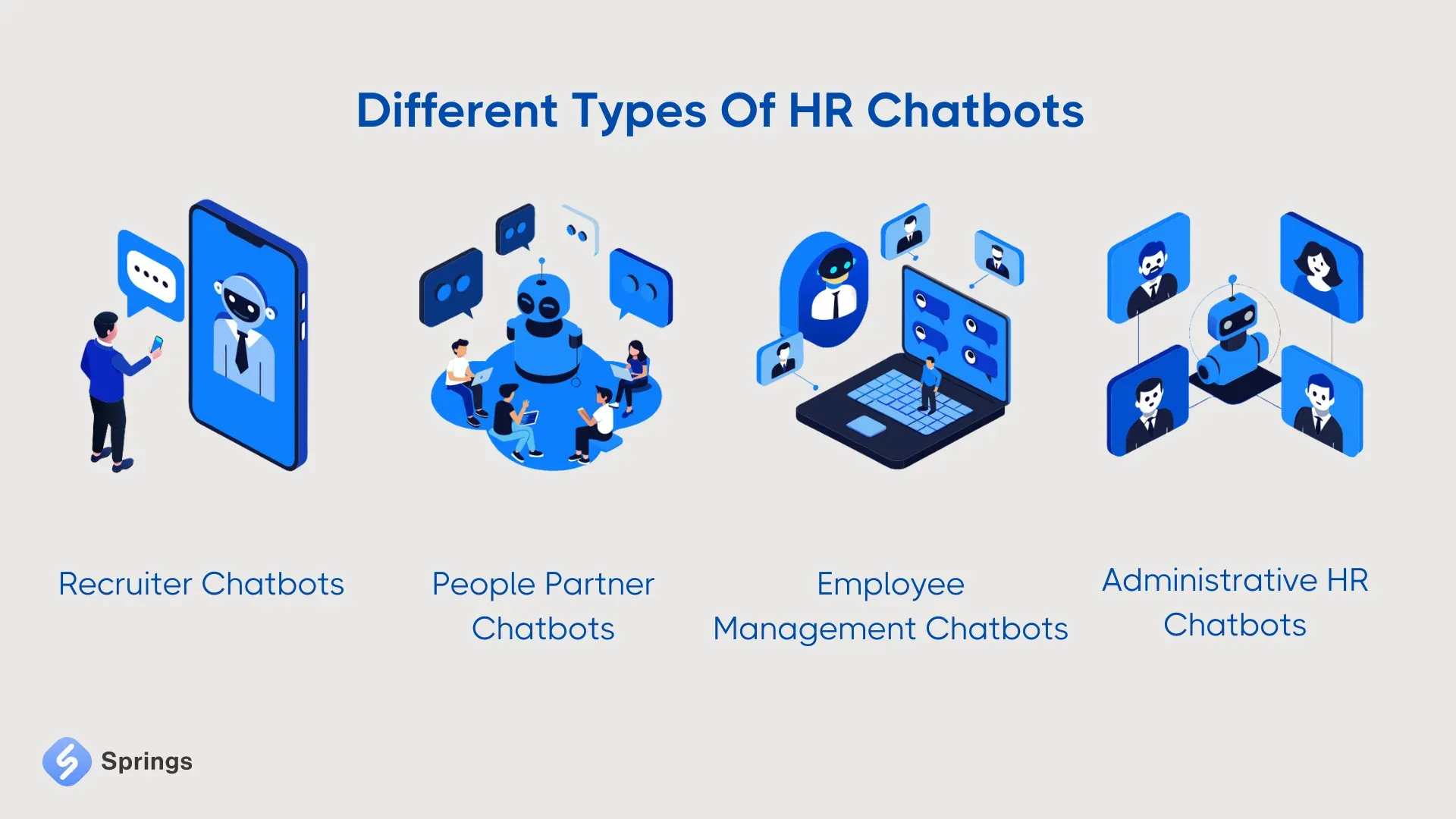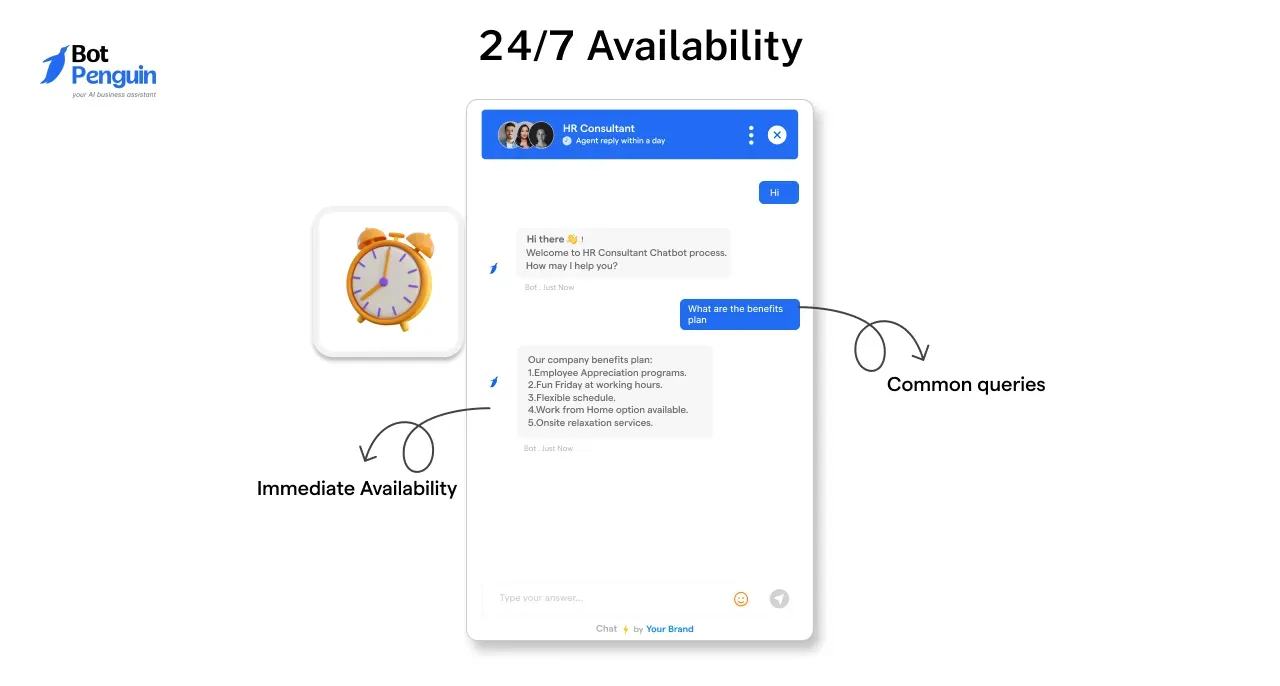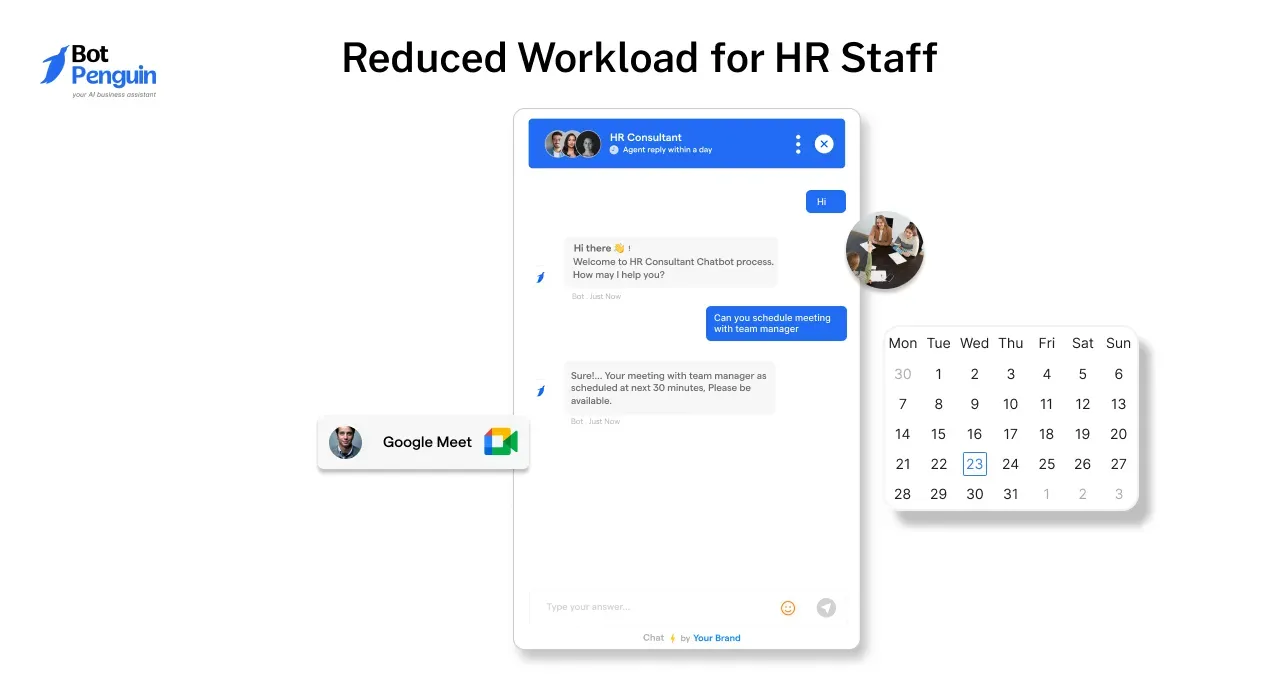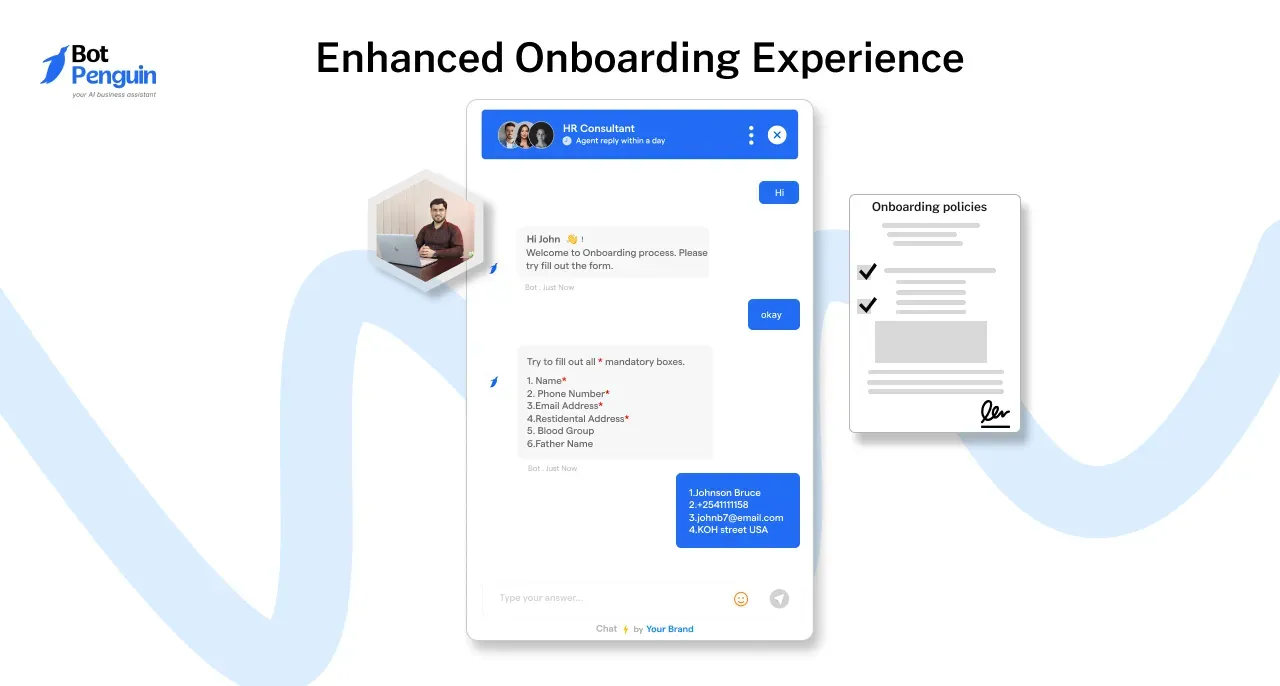The use of chatbots in human resources (HR) is becoming increasingly prevalent. HR chatbots, also known as HR helpdesk or AI chatbots for HR, are transforming how organizations manage employee-related tasks and queries.
According to a recent study by Grand View Research, the global HR chatbot market is expected to reach $701.8 million by 2028, growing at a CAGR of 12.1% from 2021 to 2028. These AI-powered HR chatbots are helping businesses streamline HR processes, improve employee engagement, and enhance the overall employee experience.
These intelligent virtual assistants are transforming the way organizations manage their human resources by automating routine tasks and enhancing employee engagement. From reducing administrative burdens to providing instant support and improving overall efficiency, HR chatbots are becoming indispensable for HR departments. Whether you’re a small business or a large enterprise, understanding these benefits can help you stay ahead in the competitive landscape and create a more productive, satisfied workforce.
In this article, we will explore the top 10 benefits of using an HR chatbot in your organization.
What are HR Chatbots?

HR chatbots are AI-powered virtual assistants designed to automate and streamline HR functions. They handle tasks like answering employee queries, scheduling interviews, and providing policy information. By using chatbots in HR, organizations can save time and reduce administrative workload. The best HR chatbots also enhance employee satisfaction by providing instant support and accessibility.
Top Benefits of Using HR Chatbots
Incorporating an HR chatbot into your organization brings a multitude of advantages, enhancing efficiency, employee satisfaction, and overall productivity. Below, we delve into the top benefits of using HR chatbots and how they can revolutionize HR operations.
1: 24/7 Availability

An HR chatbot is always available to assist employees, regardless of the time of day. This ensures that employees can get the help they need whenever they need it, without waiting for HR office hours. For instance, if an employee has a question about their benefits plan at 10 PM, they can get an immediate answer without having to wait until the next business day.
- Impact on Employee Satisfaction: Having access to HR chatbots at all times significantly boosts employee satisfaction. Employees appreciate the convenience of instant support, which helps resolve their issues promptly and efficiently. This immediate availability can make employees feel more valued and supported, knowing that their concerns can be addressed at any time.
- Examples of Common Questions Handled: Common questions that HR chatbots handle include inquiries about leave balances, company policies, and benefits information. These are routine questions that typically do not require human intervention, making them ideal for automation. By handling these common queries, chatbots free up HR staff to focus on more complex issues.
2: Quick Query Resolution
HR chatbots can provide instant answers, reducing the time employees spend waiting for responses from HR staff. This quick resolution is especially beneficial for urgent queries. In traditional settings, employees might wait hours or even days for a response, but with a chatbot, they can get the information they need immediately.
- Types of Queries Resolved Quickly: Queries related to payroll, leave requests, and general HR policies are resolved swiftly by an HR chatbot. These bots are equipped to handle a wide range of questions with speed and accuracy. This includes checking the status of a submitted form, understanding the process for requesting leave, or getting details about health benefits.
- Impact on Employee Productivity: Quick query resolution enables employees to return to their work faster, thereby improving overall productivity. They spend less time waiting for answers and more time focusing on their tasks. This immediate access to information helps maintain workflow and reduces downtime caused by waiting for HR responses.
3: Reduced Workload for HR Staff

An HR chatbot can automate many repetitive tasks such as answering FAQs, scheduling interviews, and processing leave requests. This automation frees up HR staff to focus on more strategic initiatives. By reducing the number of routine tasks, HR professionals can dedicate more time to tasks that require personal attention and strategic planning.
- Examples of Tasks Automated: Examples of tasks automated by HR chatbots include handling onboarding questions, updating personal information, and providing policy updates. These are routine tasks that no longer require direct HR involvement. Automating these tasks ensures that they are handled consistently and efficiently, without the need for manual intervention.
- Effect on HR Staff Focus and Efficiency: With repetitive tasks automated, HR staff can concentrate on more complex and value-added activities. This shift enhances their efficiency and allows them to contribute more strategically to the organization. By reducing the administrative burden, HR teams can focus on talent development, employee engagement, and other critical functions.
4: Improved Employee Engagement
HR chatbots can provide personalized interactions based on individual employee data. This customization makes employees feel valued and understood, fostering a stronger connection with the organization. For example, a chatbot can tailor responses based on an employee's role, department, or tenure, making interactions more relevant and helpful.
- Continuous Feedback and Support: An AI chatbot for HR offers continuous feedback and support, ensuring that employees always have a resource to turn to. This ongoing support enhances their engagement and morale. Employees can receive immediate feedback on their queries and concerns, which helps them feel supported and heard.
- Impact on Overall Employee Morale: Improved engagement through personalized interactions and continuous support positively impacts overall employee morale. Employees feel more connected and motivated to contribute to the organization. High morale leads to increased productivity, lower turnover rates, and a more positive work environment.
5: Consistent Information Delivery
HR chatbots ensure that all employees receive the same information. This uniformity prevents discrepancies and ensures that everyone is on the same page regarding HR policies and procedures. Consistent responses help maintain a standard of communication that is crucial for organizational coherence.
- Reducing Misinformation: By providing consistent and accurate information, HR chatbots reduce the spread of misinformation. Employees can trust the information they receive, which is crucial for maintaining a well-informed workforce. Accurate information delivery prevents confusion and ensures that employees have the correct details needed to make informed decisions.
- Importance for Policy and Compliance: Consistent information delivery is vital for policy adherence and compliance. HR chatbots help ensure that all employees understand and follow the company’s policies and regulations. This consistency is essential for maintaining legal compliance and ensuring that employees adhere to organizational standards.
6: Enhanced Onboarding Experience

An HR chatbot can streamline the onboarding process by providing new hires with all the necessary information and resources they need to get started. This makes the onboarding process more efficient and less overwhelming. New employees can receive step-by-step guidance on completing forms, understanding company policies, and accessing essential tools.
- Providing New Hires with Necessary Information: HR chatbots can deliver important information about company policies, benefits, and work culture to new hires. This ensures they are well-informed from day one and can quickly integrate into the organization. Chatbots can also answer common questions new hires have, reducing the burden on HR staff.
- Integration with Other Onboarding Tools: These chatbots can integrate with other onboarding tools, creating a seamless onboarding experience. They can guide new hires through various processes, ensuring they complete all necessary steps. Integration with tools like learning management systems or payroll software enhances the efficiency and comprehensiveness of the onboarding process.
7: Data-Driven Insights
HR chatbots collect valuable data on employee interactions and queries. This data can be analyzed to gain insights into employee needs and areas where HR processes can be improved. For example, data on frequently asked questions can highlight areas where employees need more information or training.
- Using Data for Better Decision-Making: Organizations can use the insights gathered by HR chatbots to make more informed decisions. This data-driven approach enhances the overall effectiveness of HR strategies. For instance, identifying patterns in employee inquiries can help HR develop targeted communication and training programs.
- Examples of Insights Gathered: Examples of insights include common employee concerns, frequently asked questions, and areas where additional training might be needed. These insights help HR departments to better understand and address employee needs. Data from chatbot interactions can also reveal trends in employee satisfaction and engagement levels.
8: Cost Efficiency
Implementing an HR chatbot can significantly reduce HR operational costs by automating routine tasks and reducing the need for extensive HR staff. Automation leads to cost savings by minimizing the time and resources required to handle repetitive queries and tasks.
- Long-Term Financial Benefits: The long-term financial benefits of using HR chatbots include reduced staffing costs, increased efficiency, and improved productivity. These savings can be substantial over time. By streamlining processes and improving efficiency, organizations can allocate resources more effectively.
- Examples of Cost Savings: Cost savings examples include reduced overtime pay for HR staff, decreased need for temporary staffing during peak periods, and lower training costs due to streamlined onboarding processes. Additionally, the reduction in manual errors through automation can lead to cost savings by avoiding costly mistakes.
9: Scalability
As businesses grow, HR chatbots can easily scale to handle an increased volume of employee queries and tasks. This scalability ensures that HR operations remain efficient and effective. Chatbots can manage large volumes of interactions without the need for proportional increases in HR staff.
- Handling Increased Employee Queries: An HR chatbot can manage a high volume of queries simultaneously, ensuring that all employees receive timely assistance, regardless of the organization’s size. This capability is crucial for growing organizations that experience fluctuating or increasing demands on HR services.
- Adapting to Organizational Changes: HR chatbots can adapt to changes in organizational structure, policies, and procedures. This flexibility ensures that they remain a valuable resource even as the company evolves. For instance, if a new policy is introduced, the chatbot can be quickly updated to reflect the change and disseminate the information to employees.
10: Enhanced Employee Self-Service
HR chatbots empower employees to find the information they need on their own. This self-service capability reduces the dependency on HR staff for routine queries. Employees can quickly access information about their benefits, leave balances, and company policies without waiting for HR assistance.
- Examples of Self-Service Capabilities: Self-service capabilities include accessing payslip information, updating personal details, and checking leave balances. These tasks can be easily handled by HR chatbots. For example, an employee can use the chatbot to check their remaining vacation days or to update their contact information.
- Impact on Employee Independence: By enabling self-service, HR chatbots promote employee independence and confidence. Employees feel more empowered to manage their own HR-related tasks. This independence fosters a sense of control and autonomy, which can lead to higher job satisfaction and reduced frustration with HR processes.
Conclusion
As the adoption of HR chatbots continues to grow, organizations that leverage this technology will be better equipped to stay ahead of the curve and remain competitive. Whether you're looking to streamline HR processes, provide 24/7 support, or boost employee satisfaction, investing in the right HR chatbot solution can be a transformative step for your organization.
Platforms like BotPenguin offer cutting-edge HR chatbot solutions that can be tailored to meet the unique needs of your company. As the use of chatbots in HR becomes more widespread, the future of HR looks brighter than ever, with AI-powered assistants poised to redefine the way we manage and empower our most valuable asset – our employees.
By embracing HR chatbots, you not only improve HR processes but also create a more responsive and supportive work environment. This investment in technology ultimately leads to a more efficient, satisfied, and productive workforce, setting your organization up for long-term success. Start reaping these benefits by integrating the best HR chatbots into your HR strategy today.
Frequently Asked Questions (FAQs)
What is an HR chatbot?
An HR chatbot is an AI-powered virtual assistant designed to handle routine HR tasks, provide instant support to employees, and streamline HR processes, improving efficiency and employee satisfaction.
How does an HR chatbot improve employee satisfaction?
An HR chatbot improves employee satisfaction by providing 24/7 availability, quick query resolution, personalized interactions, and consistent information, ensuring employees feel supported and valued at all times.
Can HR chatbots reduce HR operational costs?
Yes, HR chatbots reduce HR operational costs by automating repetitive tasks, reducing the need for extensive HR staff, and increasing overall efficiency, leading to substantial long-term financial savings.
How do HR chatbots enhance employee engagement?
HR chatbots enhance employee engagement through personalized interactions, continuous feedback, and support, helping employees feel more connected, valued, and motivated to contribute to the organization.
What types of tasks can HR chatbots automate?
HR chatbots can automate tasks such as answering FAQs, scheduling interviews, processing leave requests, updating personal information, and providing policy updates, freeing HR staff to focus on strategic initiatives.
How do HR chatbots provide data-driven insights?
HR chatbots collect and analyze employee interaction data, providing valuable insights into common concerns and needs, enabling HR departments to make informed decisions and improve HR strategies.



